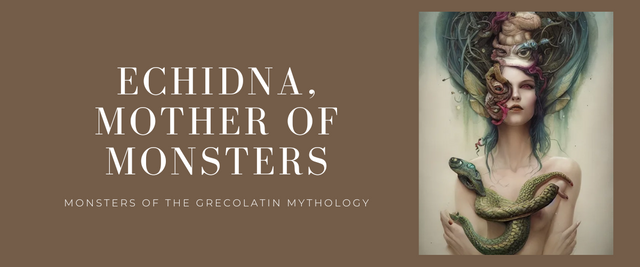Monsters of Grecolatin Mythology: Echydna, Mother of Monsters
Author's note: The following article was published in Spanish language in my Blurt blog, in November 30th, 2022.
November is ending; in the first days of this month, the Día de Muertos festivities took place, which were honored in Ancient Rome with the Parentalia and the Lemuraliad. We have also talked about the Gorgons, these beings of monstrous beauty whose looks petrify anyone who dared to look at them. And although in the month of December we won't talk about these mythological monsters for a moment, I would like to conclude this short cycle with an interesting character who, deservedly, is known in the Greco-Latin world as the Mother of Monsters: Echidna.
Who was Echydna?
In his Theogony, Hesiod (2000) describes Echydna as a character "unlike mortal humans or immortal gods […], vigorous in mind, half young woman with fair cheeks and fair eyes, half terrible monstrous serpent, enormous, brilliant, wild" (p. 42). Some authors, as Pierre Grimal (1981), point out that she lived in a cave from the Cilicia region in the Anatolian peninsula (now Turkey), in Arcadia or in the Peloponnese, where he died at the hands of Argus, the giant with 100 eyes.
Regarding who her parents were, Hesiod mentions that she was the daughter of Phorcys and Ceto, who gave birth to her in a cave. For his part, Pausanias suggests the underground river Styx as her progenitor. Meanwhile, Apollodorus places her as the daughter of Tartarus and Gaia, while other authors point her out as the result of the union of the oceanid Calirrhoe and Chrysaor, son of Medusa and Poseidon (Grimal, 1981: 165).
Mother of Monsters
Constantino Falcón Martínez, Emilio Fernández-Galiano and Raquel López Melero (1989) mention that she was the consort of Typhon, son of Gaia and Tartarus, and with whom she engendered a large offspring, among which the dogs Cerberus and Orthrus, the Lernaean Hydra, the dragonLadon , and Scylla. A version compiled by Robert Graves (2007) mentions that Echidna also maintained sentimental relations with Orthrus; from this union would be born the Chimera, the Sphinx and the Nemean Lion.
Curious is the mention of Heracles as the third lover of Echidna. According to Grimal (1981), the inhabitants of the Greek colonies of Ponto Euxino say that Echidna had stolen horses from Heracles; in order to save the steeds from her, the hero agreed to Echidna's condition to become his lover. From this union three children were born: Agathyrsus, Gelonus and Scythes, who were the first rulers of the Greek region of Scythia.
Consulted bibliography
- Falcón Martínez, Constantino; Fernández-Galiano, Emilio, y Raquel López Melero. 1989. Diccionario de la mitología clásica. Vol. 1. México. Alianza Editorial.
- Graves, Robert. 2007. Los mitos griegos. Vol. 1. México. Alianza Editorial. English version: The Greek Myths: The Complete and Definitive Edition
- Grimal, Pierre. 1981. Diccionario de mitología griega y romana. España. Paidós. English version: The Penguin Dictionary of Classical Mythology.
- Hesíodo. 2000. Teogonía. Trabajos y días, Escudo. Certamen. España. Alianza Editorial. English version: The Poems of Hesiod: Theogony, Works and Days, and The Shield of Heracles.
** The banner was elaborated with Canva. Image was created with the AI of Starryai **
Thank you, friend!


I'm @steem.history, who is steem witness.
Thank you for witnessvoting for me.
please click it!
(Go to https://steemit.com/~witnesses and type fbslo at the bottom of the page)
The weight is reduced because of the lack of Voting Power. If you vote for me as a witness, you can get my little vote.
Thank you so much for the support, @steem.history!